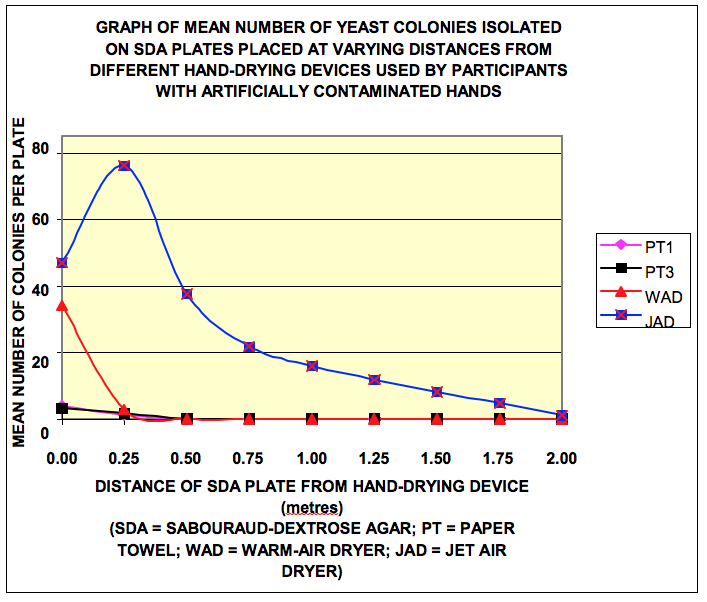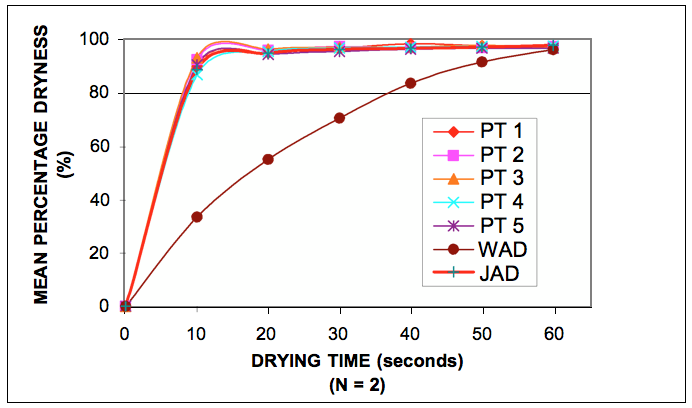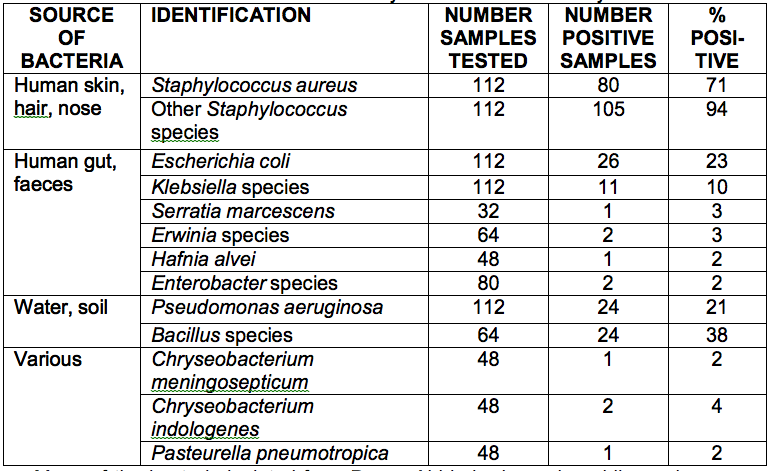There have been many studies on the benefits of hand washing and on the efficacy of different hand washing agents but relatively few on the contribution of hand drying to hand hygiene. ETS asked a research team at the University of Westminster, led by Microbiologist Keith Redway, to study the hygienic performance of several hand drying methods to take account of technology and product developments, including the recently introduced new generation jet air dryer, not tested in previous comparative studies. The main methodology used in the present study follows that used in the previous University of Westminster studies on the topic, since 1993.
The study investigated 3 different hand drying methods and was in 4 parts:
- Part A: Drying efficiency. (The amount of water remaining on the hands of subjects after washing and then drying using 5 types of Paper Towel, a Warm Air Dryer and a Jet Air Dryer dryer was measured as percentage (%) dryness at different times up to 1 minute.)
Conclusions for Part A
The results showed that the 5 types of paper towel and the Jet Air Dryer were equally efficient at drying the hands of users, all of them achieving 90% dryness in approximately 10 seconds. However, the results showed that the Warm Air Dryer was considerably less efficient (i.e. slower) than the 5 types of paper towel and also the JAD and took over 4 times as long to achieve 90% dryness of the hands.
- Part B: Changes in the number of different types of bacteria on the hands before and after drying using Paper Towel, Warm Air Dryer and Jet Air Dryer.(After visiting a washroom, the fingerpads and the palms of the hands of 20 volunteers were sampled for different types of bacteria before and after washing and drying using paper towel, warm air dryer, and Jet Air Dryer. Combined results of the bacterial counts on the three different growth media (Nutrient Agar
Conclusions for Part B
The two types of Paper Towel (PT 1 and PT 3) tested produced mean decreases in all types of bacteria tested on the fingerpads and the palms of 20 volunteers after washing and drying of the hands. The decreases were –51% and –76% for the fingerpads and –48% and –77% for the palms. The Warm Air Dryer (WAD) produced a mean increase in all types of bacteria tested on the fingerpads by +194% and the palms by +254% of the hands after washing and drying. Although the JAD performed better than the WAD, it did not perform as well as the paper towels and did not on average reduce the numbers of bacteria on the hands after use but increased them on the fingerpads by +42% and on the palms by +15%.
- Part C: Potential contamination of other users and the washroom environment caused by Paper Towel, Warm Air Dryer and Jet Air Dryer. (In this part of the study the hands of 10 subjects were artificially contaminated with yeast suspension. Subjects then dried their hands using Paper Towel, Warm Air Dryer or Jet Air Dryer for set times (10 seconds for paper towel and JAD; 20 seconds for WAD). Yeast was detected at different distances from each hand drying device by growth of colonies on Sabouraud-dextrose agar (SDA) plates.)

Conclusion for part C
The results showed that the Jet Air Dryer dispersed the contamination on the hands for distances of up to 2.00 metres. The Paper Towels performed better than the Warm Air Dryer directly below the device, but both hand drying methods showed no significant dispersal beyond 0.25 metres, unlike the Jet Air Dryers.
- Part D: Bacterial contamination of Jet Air Dryers dryers in public washrooms. (The surfaces and air flows of 16 dryers were sampled in the male and female washrooms of a main line London railway station on different days and times)
Conclusions for part D
Many of the bacteria isolated from Jet Air Dryers in public washrooms are potential pathogens (disease-causing) and/or indicators of faecal, or other types, of contamination. The mean bacterial numbers per square centimetre ranged between 85 and 171 on the inner surfaces and slits of the dryers and between 4745 and 7537 at the bottom of the dryers. Counts of a 10-second air sample ranged between 10 and 20.
Overall Conclusion of the University of Westminster
Based on these results, the use of Warm Air Dryers and Jet Air Dryers should be carefully considered in locations where hygiene is paramount, such as hospitals, clinics, schools, nurseries, care homes, kitchens and other food preparation areas.
- Full text of the “University of Westminster Study” – A comparative study on different hand drying methods: paper towel, warm air dryer, jet air dryer (Nov2008)
- A presentation of the main findings of this recent study can be viewed by clicking here (Feb2009)
- A two sided summary can be downloaded by clicking here (Feb2009)
- University of Westminster Study – Key findings (Feb 2009)
- Part C: Potential contamination of other users and the washroom environment caused by Paper Towel, Warm Air Dryer and Jet Air Dryer. (In this part of the study the hands of 10 subjects were artificially contaminated with yeast suspension. Subjects then dried their hands using Paper Towel, Warm Air Dryer or Jet Air Dryer for set times (10 seconds for paper towel and JAD; 20 seconds for WAD). Yeast was detected at different distances from each hand drying device by growth of colonies on Sabouraud-dextrose agar (SDA) plates.)
This page is also available in: French German Italian Polish Spanish














